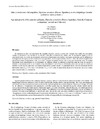Please use this identifier to cite or link to this item:
https://accedacris.ulpgc.es/jspui/handle/10553/1416
| Title: | Edad y crecimiento del raspallón, Diplodus annularis (Pisces : Sparidae), en el archipiélago Canario (Atlántico centro-oriental) | Other Titles: | Age and growth of the annular seabream, Diplodus annularis (Pisces: Sparidae), from the Canarian archipelago (central-east Atlantic) | Authors: | Lorenzo Nespereira, José María Gonzalez-Pajuelo, Jose Mario |
UNESCO Clasification: | 310510 Dinámica de las poblaciones | Keywords: | Peces Espáridos Mojarra Canarias Diplodus annularis, et al |
Issue Date: | 2002 | Journal: | Ciencias Marinas | Abstract: | Se determinó la edad y el crecimiento del raspallón Diplodus annularis de las islas Canarias. Los anillos de crecimiento anuales se observaron con claridad en los otolitos. Cada año se formaron dos anillos, uno de crecimiento rápido y otro de crecimiento lento. Los ciclos de crecimiento estacional se relacionaron con cambios fi siológicos producidos por la influencia de la temperatura del agua y el ciclo reproductor. Los ejemplares, de tallas que oscilaron desde 82 hasta 209 mm de longitud total, presentaron edades comprendidas entre 0 y 6 años. Después del primer año de vida, la tasa de crecimiento anual disminuyó claramente como consecuencia de los fenómenos de madurez sexual. La diferencia observada entre las tallas de machos y hembras a una misma edad no se consideró como una diferencia en la tasa de crecimiento entre sexos ya que los machos y hembras son los mismos individuos en diferentes fases de la sucesión sexual. Los parámetros de la curva de crecimiento de Von Bertalanffy fueron: L∞ = 248.5 mm, k = 0.259 años –1 y t0 = –0.871 años. El retrocálculo demostró la validez del uso de los otolitos para estimar la edad y el crecimiento. Age and growth of the annular seabream Diplodus annularis off the Canary Islands (Central-east Atlantic) were studied. The length range of fish was between 82 and 209 mm in total length. Otoliths showed clear growth rings. Two rings, one opaque and one translucent, were laid down each year on the otoliths. Seasonal growth cycles were related to physiological changes produced by the influence of temperature and reproductive cycle.The opaque ring was deposited during the summer months and the translucent one during the winter months. Individuals aged 0 to 6 years were found. After the first year, the annual growth rate droped rapidly as a consequence of the sexual maturity. The difference in size between males and females was not considered as evidence of an intersexual difference in growth rates since they are the same specimens at different stages of sexual succession. The parameters of the von Ber talanffy growth equation for all individuals were: L∞ = 248.5 mm, k= 0.259 year–1, and t0 = –0.871 year. The backcalculation method demonstrated the validity of using otoliths for estimating age and growth. |
URI: | https://accedacris.ulpgc.es/handle/10553/1416 | ISSN: | 0185-3880 | DOI: | 10.7773/cm.v28i1.210 | Source: | Ciencias Marinas [ISSN 0185-3880], v. 28, p. 1-11 |
| Appears in Collections: | Artículos |
SCOPUSTM
Citations
12
checked on Jun 8, 2025
WEB OF SCIENCETM
Citations
9
checked on Feb 25, 2024
Page view(s)
112
checked on Aug 24, 2024
Download(s)
119
checked on Aug 24, 2024
Google ScholarTM
Check
Altmetric
Share
Export metadata
Items in accedaCRIS are protected by copyright, with all rights reserved, unless otherwise indicated.
